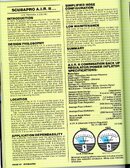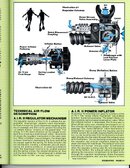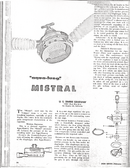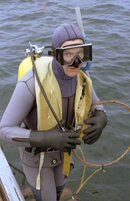I have read this entire thread, and think it's quite interesting to see different philosophies on the use of the octopus/secondary regulator/integrated power inflators. But nobody has shown Scubapro's philosphy on why they developed the A.I.R. II integrated power inflator. The below two pages come from Scubapro's 1986 Equipment Selection Guide, and explains Scubapro's philosophy on the A.I.R. II. It also gives specs for the A.I.R. II breathing characteristics (which have become better).
Now, I have never gone this route, but confess that at times my octopus does drag the river bottom (I now have neck straps--we used to call them neck straps, not necklesses, and use them).
Now, a couple of thoughts; I have used my octopus on only about two occasions, one being a complete failure of my Trieste II double hose regular due to a displaced baffle plate in the mouthpiece which covered the intake non-return valve. This is something I added when the regulator was modified to provide a more powerful Venturi. The other was when I went into the river with a Dacor Pacer regulator (plastic second stage) that had primary diaphragm that was misalligned and leaked. My first inhalation was all water, so I simple changed over to my octopus and completed the dive on it. That's it in 64 years of diving.
Concering failure points, let me as a "vintage diver" point out that the very old, Mistral double hose regulator had only 6 moving parts. It was a very, very reliable regulator. Here's an article about the Mistral from Skin Diver Magazine, and also the breathing characteristics from the U.S. Navy Experimental Diving Unit. Perhaps that is why we simply trained on buddy breathing, and left it at that. Here's the Cousteau film "Search for the Titanic's Sister Ship, Britanic," during which they used only the Mistral regulator for their deep dives. They also used a submersible decompression chamber so as to not do in-water decompression. But they used the Mistral regulator without any SPG or octopus during these dives, without problems. They did modify the Mistral regulators to include rotating the box so that the inhalation hose was over the left shoulder, due to the valve placement on the extreme left, and extending the length of the exhaust hose. They also had to reverse the mouthpiece non-return valves to reflect the new orientation of the breathing tubes.
Today's technical diver is so gear laden that sometimes they need a diver propulsion vehicle to even move, as swim fins (especially using the frog kick) don't provide enough force to move all that equipment through the water. But this is a Basic Scuba forum, and is meant for sport diving, not technical diving.
Getting back to the integrated power inflators, these are great in concept. Realize that when they were developed, very few divers were even using octopus regulators. We did not use octopus regulators on our clambed survey work in 1975, for instance. So having the A.I.R. II available was actually a breakthrough at that time, and is a good option today.
SeaRat








